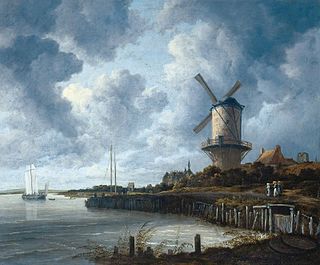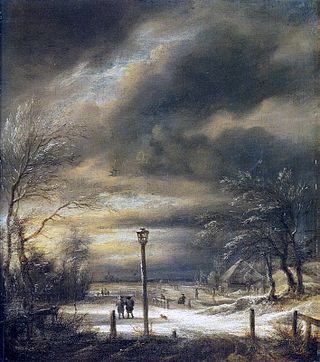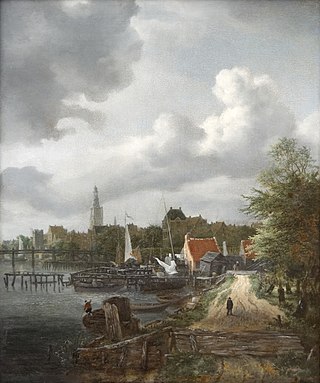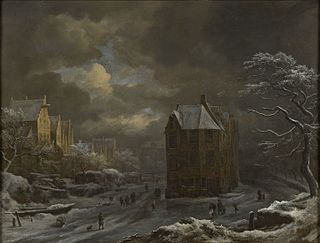
Jacob Isaackszoon van Ruisdael was a Dutch painter, draughtsman, and etcher. He is generally considered the pre-eminent landscape painter of the Dutch Golden Age, a period of great wealth and cultural achievement when Dutch painting became highly popular.

The Windmill of Wijk bij Duurstede is an oil-on-canvas painting by the Dutch painter Jacob van Ruisdael. It is an example of Dutch Golden Age painting and is now in the collection of the Amsterdam Museum, on loan to the Rijksmuseum.

The Ray of Light, also known as Le Coup de Soleil, is an oil on canvas painting by the Dutch painter Jacob van Ruisdael. It is an example of Dutch Golden Age painting and is now in the collection of the Louvre Museum.

Two Watermills and an Open Sluice near Singraven is an oil on canvas painting by the Dutch landscape painter Jacob van Ruisdael. It is an example of Dutch Golden Age painting and is now in the collection of the National Gallery.

A Landscape with a Ruined Castle and a Church is an oil on canvas painting by the Dutch landscape painter Jacob van Ruisdael. It is an example of Dutch Golden Age painting and is now in the collection of the National Gallery.

Winter Landscape near Haarlem is an oil on canvas painting by the Dutch landscape painter Jacob van Ruisdael. It is an example of Dutch Golden Age painting and is now in the collection of the Städel. This painting was documented by Hofstede de Groot in 1911, who wrote; "992. A WINTER LANDSCAPE. A snow-bound plain with trees to right and left. In the centre a road leads to the distance; away to the right is a cottage. In the centre foreground stands a solitary lamp-post. To the left of this are two travellers with a dog. Signed in full, according to the Sedelmeyer sale-catalogue, but the Frankfort catalogue does not mention a signature; canvas, 14 1/2 inches by 12 1/2 inches. Exhibited at Vienna, 1873, No. 165.

The Arrival of Cornelis de Graeff and Members of His Family at Soestdijk, His Country Estate is an oil on canvas painting by the Dutch Golden Age painters Thomas de Keyser and Jacob van Ruisdael. It is in the collection of the National Gallery of Ireland in Dublin.

Landscape with a Cottage and Trees (1646) is an oil-on-panel painting by the Dutch Golden Age painter Jacob van Ruisdael. It is in the collection of the Kunsthalle in Hamburg.

Wooded Dunes, also known as Dune Landscape, Peasant Cottage in a Landscape, Wooded Dunes and Cottage in a Grove is a 1646 oil-on-panel painting by the Dutch Golden Age painter Jacob van Ruisdael. It is in the collection of the Hermitage Museum in St. Petersburg.

Storm Off a Sea Coast, also known as The Breakwater, is a 1670 oil on canvas painting by the Dutch Golden Age painter Jacob van Ruisdael. It is in the collection of the Louvre in Paris.

View of the Binnenamstel at Amsterdam is a 17th-century oil on canvas painting by the Dutch Golden Age painter Jacob van Ruisdael. It is in the collection of the Museum of Fine Arts in Budapest.

Panoramic view of the Amstel looking toward Amsterdam is a 17th-century oil on canvas painting by the Dutch Golden Age painter Jacob van Ruisdael. It is in the collection of the Fitzwilliam Museum in Cambridge.

Winter View of the Hekelveld in Amsterdam is a 17th-century oil on canvas painting by the Dutch Golden Age painter Jacob van Ruisdael. It is in a private collection in Scotland.

Evening Landscape: A Windmill by a Stream is a 17th-century oil on canvas painting by the Dutch Golden Age painter Jacob van Ruisdael. It is in the collection of Queen Elizabeth II, on display at the Queen's Gallery at Buckingham Palace. It was acquired by King George IV in 1810.

A Thatch-Roofed House with a Water Mill, also known as Water Mill near a Farm, is a 17th-century oil on panel painting by the Dutch Golden Age painter Jacob van Ruisdael. It is in the collection of the Museum Boijmans Van Beuningen in Rotterdam.

View of the Dam and Damrak at Amsterdam, also known as The Damrak in Amsterdam, is a 17th-century oil on canvas painting by the Dutch Golden Age painter Jacob van Ruisdael. Since 1866 it is in the collection of the Museum Boymans van Beuningen in Rotterdam.

View of the Dam and Damrak at Amsterdam, also known as Quay at Amsterdam, is a 17th-century oil on canvas painting by the Dutch Golden Age painter Jacob van Ruisdael. It is since 1910 in the Frick Collection in New York. It is currently not on view.

View of the Dam and Damrak at Amsterdam is a 17th-century oil on canvas painting by the Dutch Golden Age painter Jacob van Ruisdael. It is in the collection of the Mauritshuis in the Hague. It gives a bird's eye view of the crowd watching the parade of the civic guard on the Dam Square, the main square of Amsterdam.

View of Haarlem from the Northwest, with the Bleaching Fields in the Foreground is an oil on canvas painting by the Dutch landscape painter Jacob van Ruisdael. It is an example of Dutch Golden Age painting and is now in the collection of the Rijksmuseum.

Landscape with a Windmill Near a Town Moat is an oil on canvas painting by the Dutch landscape painter Jacob van Ruisdael. It is an example of Dutch Golden Age painting and is now in a private collection.




















